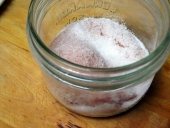


Daniel Sillito wrote:Today I want to share one of my family's favourite ways of preparing amaranth - nixtamal. It is prepared similarly to corn nixtamal. Traditionally corn is boiled in calcium hydroxide (from heat treated limestone generally), softening it, changing the protein structure to be more bio-available, and unlocking the niacin contained in the germ. The same process works on amaranth as well, but with a drastically shorter cooking time and no need to remove husks after cooking. Very little literature exists on the nutritional effects of nixtamalized amaranth, but it will (at the very least) increase the calcium content of the resulting flour. It also reduces the oxalates drastically through precipitation with the calcium in solution.
When nixtamalized, amaranth takes on a completely different flavour profile, losing any acrid or sour notes and instead takes on a prominent maize tortilla aroma with a malty flavour. My assumption is that this is because the oxalic acid is neutralized?
To get started nixtamalizing amaranth, you will need a few key pieces of equipment.
1. A sturdy steel or glazed pot. Do NOT use aluminum cookware or utensils during the cooking process.
2. A dehydrator, with a very fine mesh screen or non stick mats. In order to grind the masa in a normal grain mill, you will need to dry the grain completely.
3. A grain mill. A food processor will not grind the tiny grains effectively. If you want to be as traditional as possible, you could grind it with a Metate.
4. A very fine sieve. Even when hydrated, amaranth grains are very small. You will need a fine screened sieve in order to rinse the grain after cooking. Cheesecloth or a nut milk bag does a great job too.
Additionally you will need some food grade Calcium Hydroxide. It may be labelled as “Slaked Lime,” “Cal,” or “Pickling Lime.” It is usually derived from heating limestone to high temperature and dissolving the resulting powder. I know its possible to use wood ashes as well, but I haven't personally done it myself.
Ingredients:
3 cups amaranth grain
2 tbsp Calcium Hydroxide
8 to 10 cups of cold water
Begin by dissolving the calcium hydroxide in a pot of cold water. The exact amount of water isn’t very important, the ratio of grain to cal is what matters. Make sure you have enough water to cover the grains but leave space to allow the grain to expand.
Add the amaranth to the pot. Bring the water to a boil over medium high, stirring intermittently. When the water reaches the boiling point you will notice a rapid colour change in the water from murky to a distinct, vivid yellow colour. Set a timer for 9 minutes and turn down heat to medium. Keep the pot at a low, steady boil and stir frequently to ensure the grains don’t stick together. I use a whisk to stir.
After 9 minutes, turn the heat off but don’t take the pot off of the burner. Add 2 to 3 cups of cold water and whisk it in to completely separate all the grains and arrest the cooking process.
Ladle (if you have a small strainer) or drain the pot into a strainer and rinse thoroughly. Spread the grains out evenly on dehydrator sheets. Dry on high for 10 hours or overnight. When dried, the grains will be sticking together slightly. Break up the sheets (either by hand or in a food processor) and place in grain mill.
Grind the amaranth on a coarse setting, but still ensuring the grains are all cracked. Think similar to corn masa.
To make tortillas:
Mix 3 cups of masa, salt to taste, and 1 cup water to make a dough. Press in a tortilla press and place onto a hot, dry griddle. Cook until bubbles puff up and slightly browned on the underside, then flip and repeat.
Amaranth tortillas bond together very firmly, allowing you to use these tortillas as wraps, soft tacos, or baked/ fried into crispy chips.
Amaranth nixtamal can also be used to make tamales, atole, nacho chips, or pretty much anything corn masa can be used for.
I have experimented with the nixtamal process with many different grains, but amaranth is definitely my favourite. If there is interest I can post my recipes for other suitable grains (as well as warnings about ones that don't work).
